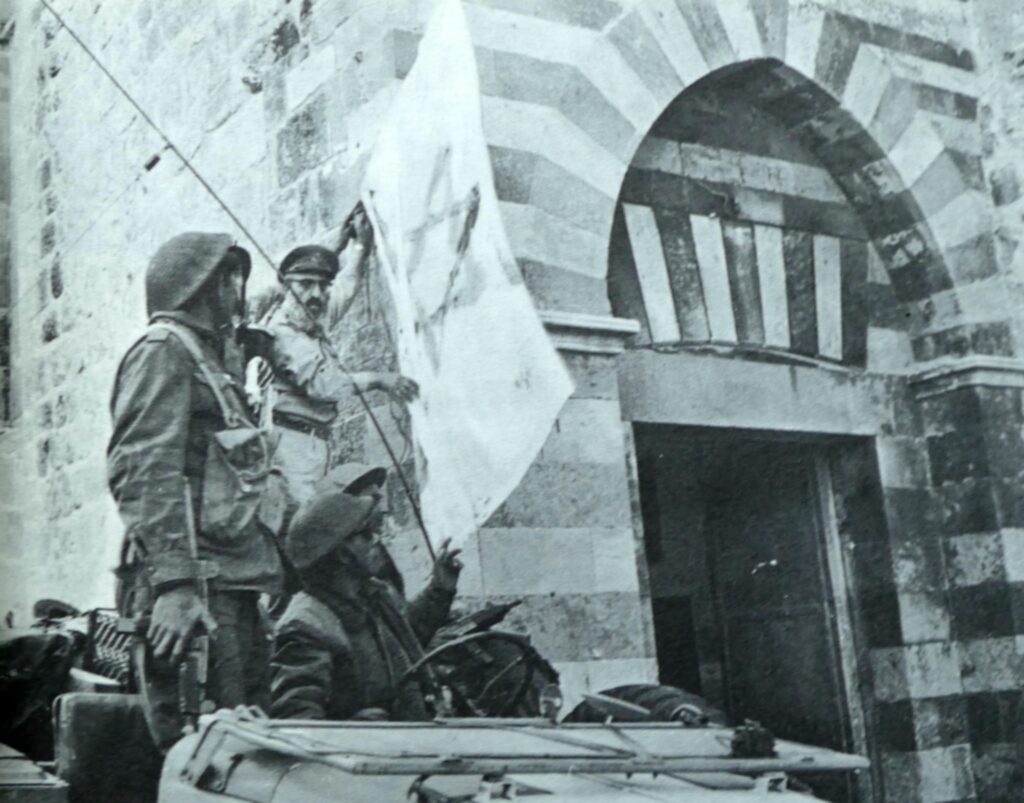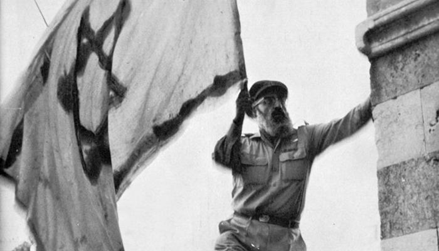As everyone knows, Monday was Yom Yerushalayim (Jerusalem Day) commemorating the reunification of Jerusalem in the 1967 Six-Day War. But not so many people know that the day after is Hebron Day, the day the City of the Patriarchs was conquered single-handedly by one rabbi.
When the IDF conquered the Temple Mount and the Western Wall, Rabbi Shlomo Goren, the chief Rabbi of the IDF, was one of the first to arrive at the Kotel. Everyone is familiar with the photograph of rabbi Goren holding a Torah scroll and blowing a shofar at the Kotel surrounded by soldiers. As a high-ranking officer and a rabbi with prophetic vision, Rabbi Goren contacted the head of the IDF, Moshe Dayan. He told him that since they had conquered the Temple Mount, it was now time to move on and conquer Hebron.

The Cave of the Patriarchs in Hebron is the site of the tombs of all the Biblical patriarchs and matriarchs, except for Rachel. It is the second-holiest site in Judaism. The Bible described Abraham’s purchase of the cave, and Jews had always lived in the holy city. The Muslims in control of the building refused to permit Jews into the Cave of the Machpela. Jews were allowed to pray outside, at the infamous “7th step”, but anyone attempting to get any closer to the entrance was beaten by the Arab guards stationed there.
In 1929, the Arabs massacred more than 60 Jews in one of the bloodiest slaughters of Jewish civilians during British rule of Mandatory Palestine. While a few Jews returned to Hebron two years later, they were eventually evacuated by British authorities, who did not want to risk the outbreak of another massacre.
Dayan was reluctant and said the IDF would go into Hebron the next day. Rabbi Goren jumped into his Jeep and ordered his driver to rush to Gush Etzion, where the troops were organizing for an assault on the holy city the next morning. Rabbi Goren addressed the troops, telling them of the enormous significance of Hebron to the Jews. He lay down to sleep surrounded by Israeli soldiers, telling them to wake him in time to leave for the battle the next day. However, when he awoke a few hours later, he was alone. The troops had moved on without him. He quickly woke up his driver and they set out to catch up with the Israeli forces.
In fact, the IDF was organizing in a separate area unbeknownst to Rabbi Goren. When he entered Hebron, Rabbi Goren was the only Jew in the city. Alone, they drove the short distance into Hebron and were greeted by flags of surrender, white sheets hanging from every window and rooftop. The rabbi didn’t see any Israeli soldiers and assumed they had already conquered the entire city. In fact, t he IDF was moving to surround the city before entering.
Rabbi Goren arrived at the Cave of the Patriarchs unchallenged, facing doors that had been locked to Jews for 700 years.He banged on the door and demanded to be allowed in. a Jordanian legionnaire peeked out and saw rabbi goren. He slammed the door shut. Rabbi Goren cocked his Uzi and fired at the door. The legionnaires that were in the Cave of the Patriarchs fled, believing that they were under attack by the main Israeli Force. Finally, after getting into Ma’arat HaMachpela Rabbi Goren blew the Shofar, as he had done 24 hours earlier at the Western Wall. He had single-handedly conquered a city of 80,000 Arabs.

The bullet holes are still there and can be seen by anyone visiting the site today. The doors did not open, so he backed his jeep up and attached chains to the doors, pulling them open.
When the IDF finally arrived at the Cave of the Patriarchs, they were shocked to see an Israeli flag flying over the building. When they entered, they found Rabbi Goren praying with a Tora scroll.
The next day he received a telegram from Minister of Defense Moshe Dayan. It read, “Take down the flag, take out the Sefer Torah, and everyone who enters must take off his shoes, because the building is a Mosque!” Rabbi Goren sent back a telegram saying, “The Sefer Torah is Kodesh (holy) – it stays. The flag means to me what it means to you. If you want to remove it, do so. I will not touch it.”
Dayan sent an officer into Hebron to remove the flag and Torah. On the way back to Jerusalem, the officer was killed in an automobile accident. Dayan then rescinded his order to remove shoes in the Ma’ara.
The Mufti of Hebron sent a messenger to ask Rabbi Goren, as a general of the Israeli army, to accept his surrender. He refused, sending back the answer, ”This place, the Tomb of Machpela, is a place of prayer and peace. Surrender elsewhere.”
It was not long after that Moshe Dayan relinquished control of the Temple Mount to Jordan and removed the Israeli flag from the Dome of the Rock. It was only recently that Jews were permitted to pray at the site, the holiest site in Judaism. Even now, religious freedom for Jews is seriously restricted.
In comparison, Jews have complete religious freedom in the cave of the Patriarchs, albeit only in half of the compound. this is clearly due to Rabbi Goren’s prophetic vision and zealous bravery for the Jewish people.




